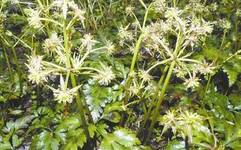
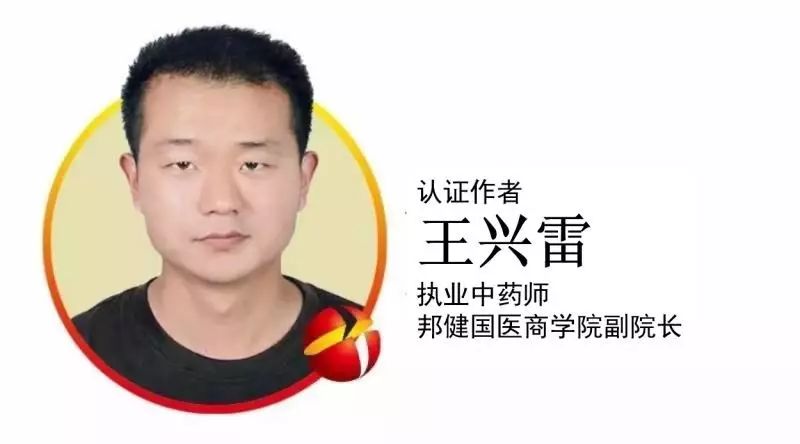
Old lady eats Huang Lian (Coptis) — bitter words from a kind heart
Rock candy boiled with Huang Lian — sharing sweetness and bitterness
Applying Huang Lian on the tip of the nose — bitterness is right in front
Huang Lian mixed with ginger — it’s been hard
Huang Lian bath — bitterness from head to toe
Soaking Huang Lian juice for three years — thoroughly bitter
A mute person eats Huang Lian — suffering in silence
When we encounter suffering in life but have no one to confide in, we often think of a saying: a mute person eats Huang Lian — suffering in silence. This indicates deep suffering, as in reality, people often have unspoken troubles that they must endure alone.
From these sayings, we can see that Huang Lian and bitterness are always connected; Huang Lian is an extremely bitter medicinal herb. In this issue, I will introduce Huang Lian.
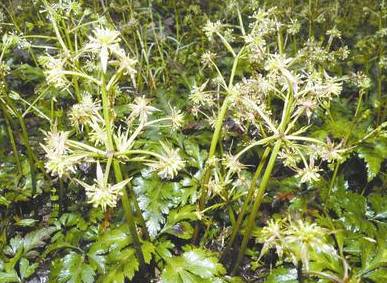
Huang Lian (Coptis)
Huang Lian was first recorded in the “Shen Nong’s Herbal Classic”. It is named Huang Lian because its rhizome is yellow and resembles a string of beads.
Huang Lian grows about a foot tall, resembling a tea bush, with one stem and three leaves. It does not wither in winter, flowers in April with yellow blooms, and bears fruit in June resembling yellow celery seeds. The roots are like strings of beads, shaped like chicken claws, with a hard outer skin and hollow inside. It is harvested in late autumn or early winter before the snow.
This product is the dried rhizome of the plants Huang Lian (Coptis chinensis), San Jiao Ye Huang Lian (Coptis teeta), or Yunnan Huang Lian (Coptis deltoidea). The medicinal materials are commonly referred to as “Wei Lian”, “Ya Lian”, and “Yun Lian”. “Wei Lian” is also known as “Chuan Lian” or “Chicken Claw Lian”. It is often branched, with 3-6 branches forming a bundle, resembling chicken or eagle claws, hence the names. It is mainly produced in Sichuan, Hubei, and Shaanxi. “Ya Lian” is also known as “Chuan Ya Lian” or “Emei Lian”. It is the rhizome of the plant San Jiao Ye Huang Lian. It is mainly produced in the Emei and Hongya regions of Sichuan Province. “Yun Lian” is also known as “Yun Huang Lian” or “Yuan Yun Lian”. It is the dried rhizome of the plant Yunnan Huang Lian. It is mainly produced in Yunnan.
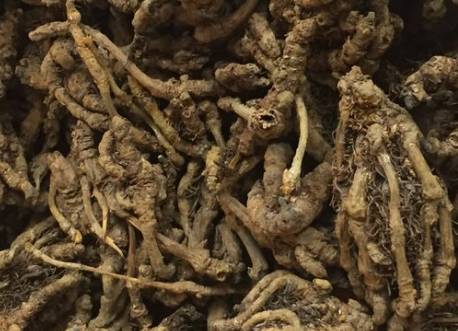
Huang Lian is generally transplanted and harvested after 4-5 years, with the best harvest time being mid-October when the medicinal efficacy is highest. If harvested too early or too late, the medicinal components will decrease. After harvesting, the soil is shaken off, and it is dried until it breaks easily. While still warm, it is placed in a bamboo trough to remove sand, roots, and residual leaf stems. “Ya Lian” is generally harvested around the beginning of winter. After shaking off the soil, it is dried until the skin is dry and the heart is moist, then screened to remove some impurities and dried completely. It is then placed in a bamboo trough to remove roots and sand, cutting off any remaining stems and excessively long parts. “Yun Lian” is dried in the sun or baked and then cleaned of roots and sand.
When Huang Lian is mentioned in prescriptions, “Chuan Lian” refers to raw Huang Lian. It is the original medicinal material, cleaned of impurities, dried, and sliced for medicinal use. Raw Huang Lian is effective for clearing heat, detoxifying, and drying dampness, as well as clearing heart and large intestine fire.
Ginger Huang Lian is made by mixing Huang Lian slices with ginger juice until absorbed, then dried for medicinal use. Ginger Huang Lian clears the stomach and stops vomiting. It is used for cold-heat complex, damp-heat obstruction, and fullness with vomiting.
Wu Zhu Yu Huang Lian is made by soaking Huang Lian slices in a decoction of Wu Zhu Yu (Evodia rutaecarpa) and then drying for medicinal use. Wu Zhu Yu Huang Lian soothes the liver and stomach and stops vomiting. It is used for liver-stomach disharmony, vomiting, and acid reflux.
Wine Huang Lian is made by spraying Huang Lian slices with yellow wine, mixing well, and drying for medicinal use. Wine Huang Lian is effective for clearing heat from the upper jiao. It is used for red eyes and oral ulcers.
Pig bile fried Huang Lian is made by spraying Huang Lian slices with pig bile, mixing well, and then lightly frying over low heat for medicinal use. Pig bile fried Huang Lian is effective for clearing liver and gallbladder fire.
Salt-fried Huang Lian is made by spraying Huang Lian slices with salt water, mixing well, and then lightly frying over low heat for medicinal use. Salt-fried Huang Lian can direct the medicinal properties downward.
Huang Lian carbon is made by frying Huang Lian slices over high heat until the outside is black and the inside is yellow, then extinguishing the fire with clean water and drying for medicinal use. It is effective for stopping bleeding.
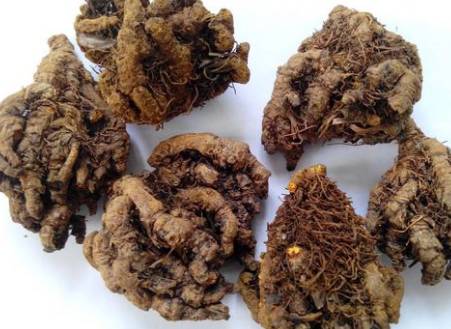
Huang Lian enters the hand shaoyin heart channel and is the main medicine for treating fire. For treating the fire of the internal organs, it is used raw; for treating the excess fire of the liver and gallbladder, it is fried with pig bile; for treating the deficiency fire of the liver and gallbladder, it is fried with vinegar; for treating the fire of the upper jiao, it is fried with wine; for treating the fire of the middle jiao, it is fried with ginger juice; for treating the fire of the lower jiao, it is fried with salt water; for treating the damp-heat fire in the qi level, it is fried with Wu Zhu Yu decoction. Various methods are not solely for guidance; spicy and hot can control its bitter cold, while salty and cold can control its drying nature, which should be carefully considered by the user.
Huang Lian is bitter in taste and cold in nature. It enters the heart, spleen, stomach, liver, gallbladder, and large intestine channels. It is primarily used to clear heat, dry dampness, drain fire, and detoxify. It is used for damp-heat fullness, vomiting, acid reflux, dysentery, jaundice, high fever with delirium, excessive heart fire, irritability and insomnia, blood heat with vomiting or nosebleeds, red eyes, toothache, thirst, and carbuncles; externally, it is used for eczema, damp sores, and ear discharge. Huang Lian is extremely bitter and cold, thus it can treat diseases caused by the confusion of water and fire. The confusion of water and fire refers to damp-heat.All medicines that can eliminate dampness must increase heat, and those that can eliminate heat cannot remove dampness. Only Huang Lian can dry dampness with its bitterness and eliminate heat with its coldness, achieving both effects simultaneously, which is unparalleled.
Everyone knows about medicinal pairs, such as Ma Huang (Ephedra) and Gui Zhi (Cinnamon Twig), Jing Jie (Schizonepeta) and Fang Feng (Saposhnikovia). Medicinal pairs are combinations of two relatively fixed medicinal herbs commonly used in TCM. Here, I will mention three well-known medicinal pairs involving Huang Lian.
Huang Lian and Ban Xia (Pinellia ternata): Huang Lian descends bitterly, which can eliminate heat generated by phlegm-dampness; Ban Xia opens with its spiciness, which can resolve the obstruction of phlegm-dampness. The two herbs work together to harmonize the stomach and regulate qi. It is used for chest fullness and nausea caused by phlegm-heat or damp-heat obstruction.
Huang Lian and Rou Gui (Cinnamon Bark): In the “Han’s Medical Communication”, it is said that it can harmonize water and fire, achieving the balance of yin and yang, hence the name Jiao Tai Wan. Huang Lian is good at clearing heart heat and draining heart fire; Rou Gui excels at warming kidney water and guiding fire back to the source. The two herbs work together to combine cold and heat, effectively treating insomnia and irritability due to disharmony between the heart and kidney.
Huang Lian and Wu Zhu Yu: One soothes the liver and relieves depression to allow liver qi to flow; the other counteracts the cold nature of Huang Lian to prevent excessive cooling while draining fire; it also helps to descend qi to harmonize the stomach and stop nausea; it guides Huang Lian into the liver channel. The combined effects of the two herbs achieve the clearing of liver fire and stopping of nausea.
The above combinations of Huang Lian are often one cold and one hot, one yin and one yang, using cold to treat heat and heat to treat cold, with the monarch and minister supporting each other, achieving the best results without the harm of excessive dominance.Other medicinal pairs include Mu Xiang (Saussurea) for heat stagnation, Zhi Ke (Bitter Orange) for hemorrhoids, Bai Shao (White Peony) for spleen fire, Shi Gao (Gypsum) for stomach fire, Zhi Mu (Anemarrhena) for kidney fire, Huang Qin (Scutellaria) for lung fire, Mu Tong (Akebia) for small intestine fire, Shan Zha (Hawthorn) for triple warmer fire, Hua Jiao (Sichuan Pepper) for calming intestinal worms, Lu Hui (Aloe) for treating childhood malnutrition, Fu Ling (Poria) for damp-heat, and Long Dan Cao (Gentiana) for liver and gallbladder fire. Each channel’s fire-clearing herbs benefit from Chuan Lian, which enhances their potency.
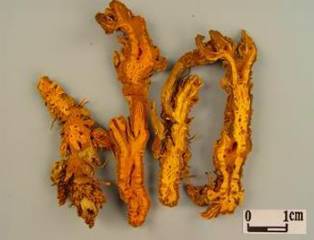
To treat cold with hot herbs and heat with cold herbs, Huang Qin, Huang Lian, and Huang Bai (Phellodendron) are commonly used in TCM to clear heat, detoxify, and dry dampness. All three are bitter and cold in nature and are often used together to enhance their heat-clearing and detoxifying effects. However, there are differences among them. Huang Qin primarily enters the upper jiao lung channel to clear lung fire and has the additional effects of calming heat during pregnancy and stopping bleeding. As stated in “Medical Origins”, “Huang Qin treats damp-heat in the lungs, alleviates upper heat with red and swollen eyes, and is essential for treating blood stasis.” Huang Lian clears heart and stomach fire and treats damp-heat in the intestines. Its heat-clearing power is the strongest. As stated in “Bencao Zhengyi”, “Huang Lian is extremely bitter and cold, drying dampness and overcoming heat, capable of draining all excess dampness and fire from the heart, spleen, liver, and kidneys, as well as the gallbladder, stomach, and intestines.” Huang Bai primarily enters the lower jiao kidney and bladder channels, excelling at clearing damp-heat from the lower jiao and restraining excessive fire. It is suitable for both excess and deficiency fire.
Thus: Huang Qin is good at clearing upper jiao fire, Huang Lian is good at clearing middle jiao fire, and Huang Bai is good at clearing lower jiao fire. For clearing fire from all three jiao, Zhi Zi (Gardenia) is often used.
Damp-heat lingering in the intestines is often treated with Ban Xia, Zhu Ru (Bamboo Shavings), and combined with Mu Xiang, Huang Qin, and Ge Gen (Pueraria) for treating dysentery. For treating warm diseases with high fever and excessive heart fire, it is combined with Zhi Zi and Lian Qiao (Forsythia). For blood heat causing bleeding, it can be combined with Huang Qin and Da Huang (Rhubarb). For heat-toxin sores and ulcers, it can be combined with Chi Shao (Red Peony) and Mu Dan Pi (Moutan). For excessive stomach fire, it can be combined with Tian Hua Fen (Trichosanthes), Zhi Mu, and Sheng Di (Rehmannia). In clinical applications, it can be combined with Da Huang and Bai Shao for purging, or with Ban Xia and Gua Lou Shi (Trichosanthes Fruit) for descending, or with Gan Jiang (Dried Ginger) and Fu Zi (Aconite) for warming, or with Ejiao (Donkey-hide Gelatin) and Ji Zi Huang (Egg Yolk) for moistening, or with Ren Shen (Ginseng) and Gan Cao (Licorice) for tonifying, depending on the condition, thus achieving the benefits of bitterness and dryness without the drawbacks of excessive bitterness and dryness.
Huang Lian is often used in combination with warming herbs to clear fire from the heart, which is a fixed principle. Any fire-draining and heart-clearing herbs must include Huang Lian, and the dosage must be appropriate; excessive dosage can lead to coldness in the lower jiao and exacerbate heat in the upper jiao. Inexperienced practitioners may mistakenly believe that prolonged use of Huang Lian will lead to fire transformation.
For those with yin deficiency and heat, stomach deficiency with vomiting, or spleen deficiency with diarrhea, caution should be exercised in using Huang Lian.
Medicinal transmission does not convey dosage; it is only half the transmission. In the past, families of TCM practitioners kept the use of herbs and dosages secret, never passing them on to outsiders, and even within the family, they would pass them down to sons but not daughters. If a generation unintentionally does not learn medicine, the knowledge may be lost over time.It is well known that herbs are the components of formulas, while dosage is the soul of the formula’s composition.The secret of TCM lies in the dosage. Zuo Jin Wan is composed of 6 liang of Huang Lian and 1 liang of Wu Zhu Yu, with a ratio of 6:1. Its effect is to clear liver fire and stop nausea. It is used for liver fire invading the stomach, causing noisy stomach and acid reflux. If Huang Lian and Wu Zhu Yu are used in equal amounts, it is taken with congee to treat persistent diarrhea, red and white dysentery, and abdominal pain. Conversely, if the ratio of Huang Lian to Wu Zhu Yu is changed to 1:6, Zuo Jin Wan treats liver fire invading the stomach, while the reversed Zuo Jin Wan treats liver cold invading the stomach. The herbs remain the same, but the diseases treated are completely opposite, demonstrating the remarkable subtleties involved. In clinical applications, the dosage ratio must be flexibly adjusted according to the nature of the disease to achieve efficacy; one cannot have a formula without the appropriate herbs.Additionally, in the clinical application of Jiao Tai Wan, attention should be paid to the amount of Huang Lian for excessive heart fire, while the amount of Rou Gui should be increased for cold kidney water.

For the same patient, several experienced TCM practitioners can prescribe different formulas. In Jin Yong’s novels, the martial arts world is divided into various sects such as Shaolin, Wudang, Emei, Kunlun, and Kongtong. Similarly, TCM has many schools of thought. China is vast and diverse, with significant climatic differences, leading to various diseases, which in turn has resulted in many schools and texts in TCM. The Yin Nourishing School must read Zhu Danxi’s “Danxi’s Heart Method”; the Earth Supplementing School must read Li Dongyuan’s “Treatise on Spleen and Stomach” and “Secret Collection of Orchid Room”; the Cold and Cool School must read Liu Wansu’s “Suwen Xuanji Yuanbing” and “Xuanming Lun Fang”; the Purging School must read Zhang Zizhong’s “Zizhong Medical Collection”, etc.
In the Jin Dynasty, doctors often used warm, spicy, and aromatic herbs, which could easily harm yin and damage yang energy. Liu Wansu summarized the clinical experience of using cold and cool herbs as the main treatment method. Zhang Congzheng built upon his mentor Liu Wansu’s principles, emphasizing the importance of expelling pathogens; when the pathogens are removed, the body will be at peace. One should not fear purging while nurturing the disease, and he emphasized the use of sweating, vomiting, and purging as essential treatments. This established the theory of the Purging School, making Zhang Congzheng a master of this school. Medicine is divided into eight principles, and the human body is merely a reflection of the exterior and interior, with qi and blood being either deficient or excessive, and medical methods being either purging or tonifying. Among the many schools of TCM, only Zhang Congzheng’s Purging School excels in using purgative herbs. For the upper body, one can induce vomiting; for the exterior, sweating is appropriate; and for the interior, purging is suitable.
The main source of Huang Lian products is artificial cultivation. “Wei Lian” is mainly distributed in Sichuan, Hubei, Yunnan, Shaanxi, Gansu, Hunan, and Guizhou. It is primarily produced in Shizhu, Emei, and Hongya in Sichuan; Lichuan and Enshi in Hubei. Shizhu in Sichuan and Lichuan in Hubei are known as the hometowns of Huang Lian. Emei and Hongya are praised as the hometowns of “Ya Lian”. “Yun Lian” is distributed in the northwestern part of Yunnan and the southern part of Tibet.
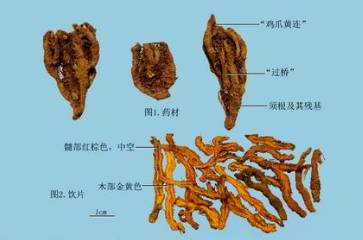
“Wei Lian” is often branched, clustered, and resembles chicken claws, with a yellow-brown surface, irregular nodules, and root hairs or root hair marks. Some internodes are smooth, commonly referred to as “over the bridge”, with brown scales or leaf stem remnants remaining at the top. It is hard in texture, with an uneven fracture surface, dark brown skin, golden yellow wood, and radial patterns, with a hollow central pith. It is extremely bitter.
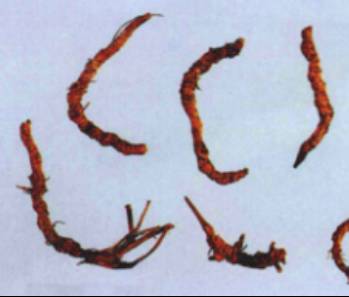
“Ya Lian” is often single-stemmed, slightly cylindrical, with longer “over the bridge” sections and a small amount of residual stem at the top.

“Yun Lian” is often single-stemmed, smaller, with a brown-yellow surface. It has “over the bridge” sections, and the fracture surface is relatively flat and yellow-brown.
“Wei Lian” is best when it is thick, with a yellow-brown surface and a golden yellow fracture surface, extremely bitter, and free from broken sections, residual stems, dryness, impurities, or mold.
“Ya Lian” is best when it is thick, hard, with a yellow-brown surface and a golden yellow fracture surface, extremely bitter, and free from broken sections, hairs, dryness, impurities, or mold.
“Yun Lian” is best when it is thick, solid, with a yellow-brown surface and a golden yellow fracture surface, extremely bitter, and free from hairs, “over the bridge” sections, impurities, or mold.
The price of Huang Lian has remained very stable. One reason is that there are no alternative varieties to replace it, and it requires a long cultivation time and complex processing, which involves using charcoal fire and iron sheet rolling machines to remove root hairs. Secondly, Huang Lian is a genuine medicinal material that has strict requirements for terrain, soil, temperature, light, and rainfall. Cultivating Huang Lian requires specific latitude, longitude, and altitude, and the land used for planting Huang Lian cannot be replanted. The special geographical conditions determine its stability. Some Huang Lian on the market are from roots affected by root rot disease, and the content of effective components such as berberine and coptisine in these diseased Huang Lian is far below the national pharmacopoeia standards. Such products are not as hard as the genuine ones, and their radial patterns are not obvious.
While working at Tong Ren Tang, the old doctor often shared wisdom with us young people. I remember one day when he talked about Huang Lian, he said that in the past, the market’s chicken claw Huang Lian was all about the size of Huang Lian, with many root hairs, and breaking one open would reveal a lot of dirt inside, truly one pound of Huang Lian and half a pound of dirt. Nowadays, most pharmacies sell longitudinally sliced Huang Lian.
There are also issues of counterfeit Huang Lian on the market, such as those dyed with gold amine O, and there are also issues with the purification and weight increase of Huang Lian. I have seen a type of Huang Lian slices on the market that are noticeably hard and have a very uniform and bright color. It seems they have been artificially weighted and dyed. If you are unsure, it is advisable to purchase whole Huang Lian roots. When purchasing whole roots, pay attention to the root hairs, whether there is dirt, and the moisture content. Break them to check for dryness or mold, and choose fresh and high-quality products.
Postscript
In ancient times, when a noble had an illness and the heavens did not rain, many doctors came to treat him, but none were effective. Finally, one doctor arrived, took the pulse, and calculated the time, saying: “It will rain tonight.” He then left without mentioning a treatment plan. The noble was suspicious and asked, “Are you saying my illness cannot be treated? Why mention rain instead of treating me?” Later, it indeed rained, and the noble was delighted and got up to walk in the courtyard. By dawn, his illness had disappeared. The next day, the doctor who had come later visited, and the noble was happy and asked, “You predicted rain and I recovered; why is that?” The doctor replied, “Your illness was caused by worry, and you were worried about the drought. With the rain, your worry is alleviated, and naturally, you recover without needing medicine.” Such a doctor can be said to have grasped the way of medicine. The formulas and prescriptions are available for everyone to use. Seeking understanding beyond words and grasping the unspoken meaning is a rare skill; who can achieve that?
Why speak of illness only in terms of rain? Such a doctor can be said to have attained the way of medicine. Understanding the principles of heaven and earth, what is the significance of a mere physical body? The formulas in the books are available for every doctor to use. Seeking understanding beyond words and grasping the unspoken meaning is a rare skill; who can achieve that?
Illness cannot speak for itself; the doctor must use their skills. Plants and trees are not without feelings; they have their own powers.

Long press the image for 3 seconds to scan the QR code and follow us
If you like it, please give us a thumbs up!↙

